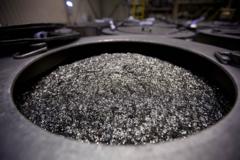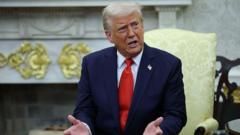China's new restrictions on the export of vital rare earth minerals raise alarms over America's reliance on these critical resources. The ongoing trade tensions may further escalate, jeopardizing U.S. technological innovation and defense capabilities.
The Impact of China's Rare Earth Export Controls on the U.S. Economy

The Impact of China's Rare Earth Export Controls on the U.S. Economy
As China tightens its grip on rare earth exports, the repercussions for the U.S. economy and defense sector are becoming increasingly evident.
As the trade dispute between China and the U.S. intensifies, attention has shifted beyond retaliatory tariffs to China's recent export limitations on essential rare earth minerals. This strategic move reveals America's significant reliance on these resources, prompting the U.S. government, under Trump, to explore ways to increase domestic production of critical minerals.
Rare earth elements, despite their name, are not truly rare but are challenging to extract in pure form due to their hazardous nature. These elements, including Neodymium, Yttrium, and Europium, are integral to the production of a myriad of high-tech products, from smartphones to sophisticated medical devices like MRI machines. Neodymium is particularly vital for creating powerful magnets found in various technologies, including electric vehicle motors and consumer electronics.
China holds a dominant position in the rare earth supply chain, controlling 61% of global rare earth production and an overwhelming 92% of refining processes. This monopoly arises from deliberate government policies and investments over decades, enabling China to outcompete global counterparts in both pricing and production capacity.
In retaliation against U.S. tariffs, China recently implemented restrictions on the export of seven rare earth minerals, especially "heavy" rare earths crucial for defense applications. As a result, U.S. companies now require special export licenses to procure these minerals, which could have dire implications for industries that heavily depend on them.
The U.S. Geological Survey has highlighted that between 2020 and 2023, approximately 70% of rare earth imports came from China. This dependency creates vulnerabilities, particularly for the U.S. defense sector, where many technologies, including advanced weaponry like F-35 jets and missiles, rely on these minerals. The situation is compounded as China's military production accelerates ahead of U.S. capabilities.
The looming disruption in supply has sent shockwaves through American industries, with manufacturing sectors facing potential shortages and delays in production. Economic experts predict a sharp rise in the costs of essential materials as companies scramble to adapt, possibly leading to longer-term shifts in U.S. sourcing strategies. Although there have been calls for increased domestic mining and processing capacity, achieving this will require substantial investment and technological advancements.
The situation has prompted Trump to order an assessment of national security risks linked to the reliance on these critical resources. With interests extending to partnerships with nations like Ukraine and Greenland—both having rich rare earth deposits—the U.S. aims to diversify its supply chains. However, the adversarial stance towards past allies may further complicate these efforts.
The U.S. faces a dual challenge: managing its precarious dependency on China's rare earth exports while mending diplomatic relationships with other nations to ensure sustainable access to these vital minerals. The extent of cooperation from these nations amid the escalating trade war is uncertain and raises questions about America's long-term economic resilience.






















